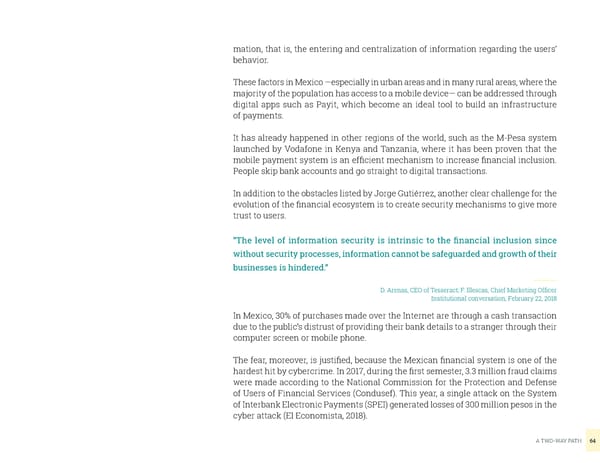mation, that is, the entering and centralization of information regarding the users’ behavior. These factors in Mexico ―especially in urban areas and in many rural areas, where the majority of the population has access to a mobile device― can be addressed through digital apps such as Payit, which become an ideal tool to build an infrastructure of payments. It has already happened in other regions of the world, such as the M-Pesa system launched by Vodafone in Kenya and Tanzania, where it has been proven that the mobile payment system is an efficient mechanism to increase financial inclusion. People skip bank accounts and go straight to digital transactions. In addition to the obstacles listed by Jorge Gutiérrez, another clear challenge for the evolution of the financial ecosystem is to create security mechanisms to give more trust to users. “The level of information security is intrinsic to the financial inclusion since without security processes, information cannot be safeguarded and growth of their businesses is hindered.” D. Arenas, CEO of Tesseract; F. Illescas, Chief Marketing Officer Institutional conversation, February 22, 2018 In Mexico, 30% of purchases made over the Internet are through a cash transaction due to the public’s distrust of providing their bank details to a stranger through their computer screen or mobile phone. The fear, moreover, is justified, because the Mexican financial system is one of the hardest hit by cybercrime. In 2017, during the first semester, 3.3 million fraud claims were made according to the National Commission for the Protection and Defense of Users of Financial Services (Condusef). This year, a single attack on the System of Interbank Electronic Payments (SPEI) generated losses of 300 million pesos in the cyber attack (El Economista, 2018). A TWO-WAY PATH 64
 Fintech in LATAM | EY | Startupbootcamp FinTech | IPADE Page 63 Page 65
Fintech in LATAM | EY | Startupbootcamp FinTech | IPADE Page 63 Page 65